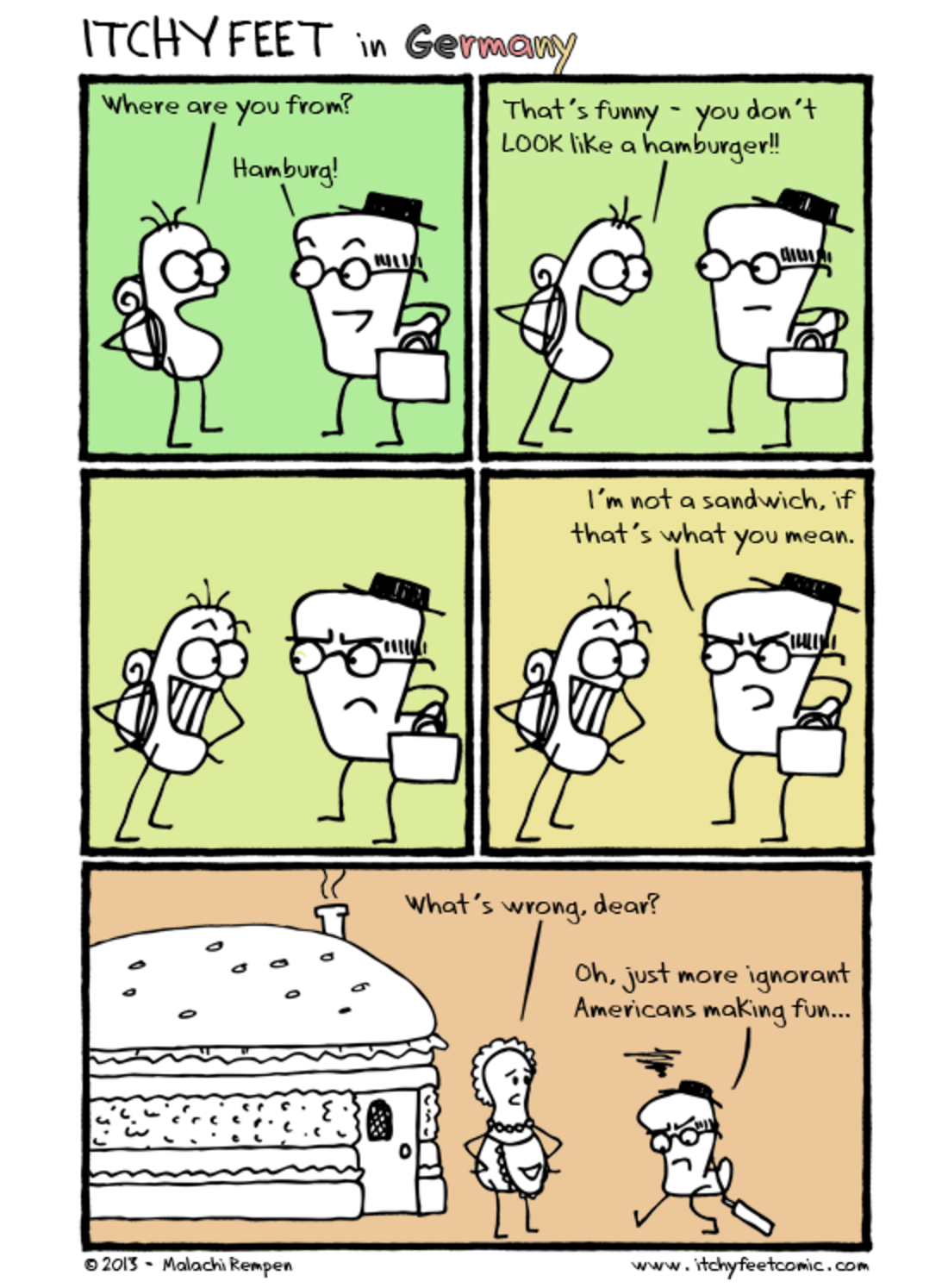Ich bin ein Hamburger (and Other Delicious German Demonyms) Posted by Malachi Rempen on May 23, 2016 in Archived Posts

As you probably know, the English word “hamburger” has long caused confusion among children and the geographically impaired. After all, there’s no ham in a hamburger – it’s made of beef! How does that make sense? And what about wieners and franks? Why do hot dogs have so many odd names?
The answer is both in German demonyms (the word used to describe a person from a certain place – like “New Yorker” or “Dutchman”) and the German system for naming their traditional foods by identifying where it’s from.
But before we get to Hamburg, we’ve got to start with hot dogs.
Frankfurter
You’ve probably heard of Frankfurt, the city in central Germany with a lot of banks and one of Europe’s largest airports. Well, you’ll be unsurprised to learn that in German, a Frankfurter is someone – or something – which hails from this fine city. Now, a Würstel is a type of boiled sausage – the original type brought over to the USA which became known as a “hot dog” (someone thought it resembled a dachshund, the sausage-like German dog, and you can probably connect the dots from there). A Frankfurter Würstel is the type of Würstel which comes from Frankfurt.
Wiener
I can already see the gears turning in your head: “so if a frankfurter is a sausage from Frankfurt, a Wiener is a sausage from…Ween?” Very close, my friend. Wien (pronounced “ween”) is the German word for Vienna, the capital of Austria. And yes, a Wiener Würstel is the full name for the sausage which comes from Vienna…you might even have seen it called a “Vienna sausage” in English. This also will explain to you what a Wiener Schnitzel is: a schnitzel (a type of deep-fried breaded beef steak) which comes from Vienna. A Wiener Schnitzel is NOT a sausage, a fact made all the more confusing by the name of the American fast food chain Wienerschnitzel, which only serves hot dogs, not steaks. Your guess is as good as mine on that one.
The garnish on this whole dog is that Wiener Würstel is very rarely used in Vienna itself to refer to a Vienna sausage – in fact, most of these places only use the demonyms if they’re outside the city being referred to. More on that in a minute.
Krakauer / Nürnberger / Thüringer
Similar to Wien, Krakau is the German spelling of Krakow, Poland, from where this particular sausage – the Krakauer – comes. Same with the Nürnberger and the Thüringer, both names of types of sausages, as well as people from the German cities of Nürnberg and the region of Thüringen. This is making me very hungry.
Hamburger
Ah, here we are, finally: the hamburger. Easy enough: a hamburger is a cut of meat that comes from Hamburg. Right? Pretty much, except the difference with hamburgers is that they were given the name in the USA, not in Germany. The “Hamburg steak” was minced beef, eaten raw (a dish still enjoyed in Germany), and apparently thought to hail from Hamburg. Fear not, my America-loving friends: the hamburger itself IS an American invention.
The food is popular now in Germany, of course, where they use the burg suffix to make all kinds of puns – there are restaurants called Stadtburger (literally “city citizen,” but which can also be understood as “city burger joint”), Kreuzburger (referring to the popular Berlin district of Kreuzberg) and Burgermeister (the Bürgermeister, or “city master,” is the German word for “mayor” – but without the umlaut, “Burgermeister” becomes “master of burgers”). And speaking of Berlin…
Berliner
You’ve probably heard the story of John F. Kennedy’s 1963 speech in Berlin, where he said “Ich bin ein Berliner,” and everyone laughed because Berliner means “jelly doughnut.” Well, that’s not true. “Ich bin ein Berliner” means exactly what JFK meant it to mean: “I am a Berliner,” as in, “I am one with the people of Berlin.”
However…a Berliner is, in fact, a jelly doughnut. It’s just that no one thought JFK was referring to himself as one. A doughnut in German is called a Pfannkuchen (a word also now used to refer to pancakes, which Pfannkuchen literally translates to), and a Berliner Pfannkuchen is a very particular Berlin-style jelly-filled doughnut topped with powdered sugar. They’re wonderful.
Amerikaner
Yes, an Amerikaner in German is someone who is American, but it’s also a particular kind of black-and-white spongy cookie. I myself grew up in the USA, lived there for 24 years, and never once saw anything like this – but I’ve since learned it’s popular in New York, and originated there. Live and learn.
Pariser
This is the only one on the list you probably won’t want to sink your teeth into: a Pariser, while technically meaning someone hailing from Paris, is also German slang for a condom.

Build vocabulary, practice pronunciation, and more with Transparent Language Online. Available anytime, anywhere, on any device.




Comments:
Karen K:
the black & white cookie plays a key role in a hilarious episode of Seinfeld, which, of course, happens in New York.
Ethan:
Berliner’s are Brock’s favourite, nothing beats a Berliner!
John Mullen:
Wien is not pronounced like “Ween” in English, as there is no English W-sound in the German language. The “W” is, instead, pronounced with an English V-sound. It is pronounced like “Veen”. Also, Wienerschnitzel is always made from veal. If it is not veal, then it cannot be legally sold as “Wienerschnitzel” within the EU. Merchants get around the rule by otherwise referring to the product as “Schnitzel Wiener Art”. (Schnitzel Vienna style)
Wiener Schnitzel is: a schnitzel (a type of deep-fried breaded beef steak)
Mike Birbeck:
Great site and some fascinating “insights” to the marvelous language that is German.